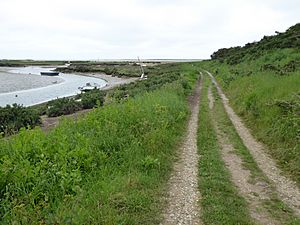Morston Cliff facts for kids
| Site of Special Scientific Interest | |
 |
|
| Area of Search | Norfolk |
|---|---|
| Interest | Geological |
| Area | 1.0 hectare (2.5 acres) |
| Notification | 1984 |
| Location map | Magic Map |
Morston Cliff is a special place in Norfolk, England. It is a geological Site of Special Scientific Interest, which means it's protected because of its important rocks and landforms. This area is about 1 hectare (or 2.5 acres) in size.
It is located east of Wells-next-the-Sea. Morston Cliff is also part of the Blakeney National Nature Reserve. This reserve is looked after by the National Trust, a charity that protects special places. It's also within the Norfolk Coast Area of Outstanding Natural Beauty. This means the landscape here is very beautiful and important.
Contents
What Makes Morston Cliff Special?
Morston Cliff is a very important site for understanding Earth's past. It is known as a Geological Conservation Review site. This means it has rocks and features that are key to studying geology in the UK.
The cliff holds clues from the Pleistocene epoch, which was a time of many ice ages. It has a unique feature: a "raised beach" deposit. This is the only one of its kind in East Anglia. A raised beach is an old beach that is now higher than the current sea level. This happens when the land rises or sea levels change over a very long time.
A Window to the Ice Age
The deposits at Morston Cliff tell us about a warm period called the Ipswichian interglacial. This was a time between two major ice ages. Scientists believe this warm period happened around 125,000 years ago. During this time, the climate was much warmer than today.
The Ipswichian Warm Period
The "interglacial" period means it was a warmer time when the ice sheets had melted back. The raised beach at Morston Cliff formed during this warm spell. It shows us what the coastline was like many thousands of years ago.
The Devensian Ice Age
Above the old beach deposits, you can see layers from a much colder time. These are called glacial deposits from the late Devensian period. The Devensian was the most recent ice age in Britain. These deposits include something called the Hunstanton Till. Till is a type of rock and soil left behind by glaciers as they moved across the land.
So, Morston Cliff shows us a clear picture of how the climate changed. It goes from a warm interglacial period to a cold ice age. This makes it a fantastic outdoor classroom for geologists and anyone interested in Earth's history.
Exploring the Area
If you visit Morston Cliff, you can also enjoy the beautiful surroundings. The Peddars Way and Norfolk Coast Path both pass through this site. These are popular walking trails. They offer amazing views of the coast and a chance to explore the natural beauty of Norfolk.

